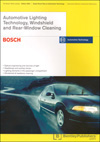|
Automotive Lighting Technology, Windshield and Rear-Window Cleaning
Price: $24.95
|
Introduction
Today, it is virtually impossible to imagine night driving without headlamps. These basic components of modern-day automotive equipment are essential elements in the vehicle's safety equipment.
Current headlamps and lighting equipment must comply with an extensive catalog of requirements. These include minimizing the blare for oncoming drivers in today's increasingly dense traffic, while at the same time ensuring efficient illumination of the road surface, regardless of speed. Also of high importance are the signal effects of the lamps, displays and controls in the vehicle's interior, and their clear arrangement and efficient illumination. Headlamp design is yet another factor which is coming more and more to the forefront. Since the headlamps are the vehicle's ?eyes?, they are the object of increased attention in the symbiosis of form and function that characterizes vehicle styling. Computer-aided lighting (CAL) has fostered the development of such headlamp concepts as the reflection headlamp with stepless or partitioned reflectors, the Poly-Ellipsoid System (PES) projection headlamp, the "Litronic? headlamp system with Xenon gaseous-discharge lamp, the headlight leveling control, and other lighting concepts serve to optimise the headlamp's efficiency.
Since they ensure highly efficient and sophisticated windshield and headlamp cleaning, wipe/wash systems make a major contribution to safety. A rain sensor is used with high-end installations for instance, to provide the signal for switching on the wipers with their one-piece, jointless Aerotwin wiper blades which slide over the windshield with even pressure and without causing wear. Such installations, with their electronically controlled drives always ensure the largest-possible wiped area ? even when there is a strong headwind and the windshield is dry or partially dry, or even when it is covered by a layer of snow.Thanks to innovative electric motors with electronically reversible direction of rotation, these systems can be adjusted manually to the correct speed for the rain on the windshield, or they are adjusted automatically in line with the rain-sensor signal. And last but not least, electronically controlled wipers return the wiper blades to a parking position where they don't limit the driver's field of vision.
In this manual you will read, in an easily understandable form, about the basics of lighting technology and windshield cleaning, and how these are applied in automotive technology.
![[B] Bentley Publishers](http://assets1.bentleypublishers.com/images/bentley-logos/bp-banner-234x60-bookblue.jpg)
